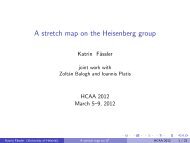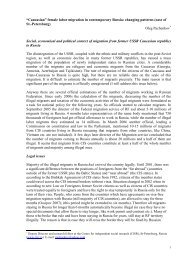THORIUM AS AN ENERGY SOURCE - Opportunities for Norway ...
THORIUM AS AN ENERGY SOURCE - Opportunities for Norway ...
THORIUM AS AN ENERGY SOURCE - Opportunities for Norway ...
Create successful ePaper yourself
Turn your PDF publications into a flip-book with our unique Google optimized e-Paper software.
Thorium as an Energy Source - <strong>Opportunities</strong> <strong>for</strong> <strong>Norway</strong><br />
17. LIST OF FIGURES<br />
Figure 2.1: Electricity Production by Source in 2004. ........................................................................................ 7<br />
Figure 2.2: Greenhouse Gas Emission by Electricity Production Method. ......................................................... 8<br />
Figure 2.3: Historic and Estimated Future World Energy Consumption and Carbon Dioxide (CO2) Production<br />
(IEA Reference Scenario)................................................................................................................. 8<br />
Figure 2.4: Production of Petroleum in <strong>Norway</strong> from 1971 to 2006................................................................. 11<br />
Figure 2.5: Electricity Price (“System Price”) from 1996 to 2006.................................................................... 12<br />
Figure 2.6: Electricity Production and Consumption in <strong>Norway</strong> from 1970 to 2007 (Estimated to 2020). ...... 13<br />
Figure 2.7: Numbers of Reactors in Operation Worldwide (as of August 8, 2007).......................................... 14<br />
Figure 2.8: Number of Operating Reactors by Age (as of June 26, 2007). ....................................................... 15<br />
Figure 2.9: The Evolution of Nuclear Power. ................................................................................................... 15<br />
Figure 2.10: The World Uranium Resources (Mining Costs < 130 US$/kgU). .................................................. 17<br />
Figure 2.11: Cumulative Natural Uranium Demand and Resource Levels (Case: Continued Nuclear Growth). 18<br />
Figure 2.12: The World Uranium Spot Price History. ........................................................................................ 19<br />
Figure 2.13: Thorium Deposits in the World. ..................................................................................................... 20<br />
Figure 2.14: The World Thorium Reserves and Reserve Base (Resources)........................................................ 20<br />
Figure 3.1: Bedrock Geology of the Fen Central Complex............................................................................... 24<br />
Figure 3.2: Thorium in the Upper Soil and Bedrocks of the Fen Central Complex. ......................................... 26<br />
Figure 3.3: Uranium in the Upper Soil and Bedrocks of the Fen Central Complex.......................................... 26<br />
Figure 3.4: Photo of a Thin Section of Fen Iron-Rich Carbonatites Examined on SEM-Electron Microscope.27<br />
Figure 3.5: Map of <strong>Norway</strong> Showing the Location of Thorium-rich sites. ....................................................... 28<br />
Figure 4.1: Fission Gas Release Rates with Modern, High Quality, TRISO Fuels........................................... 37<br />
Figure 5.1: Relevant Isotopes in the Thorium Cycle......................................................................................... 38<br />
Figure 5.2: Absorption Cross Section of Thorium-232 (Th-232) in the Epithermal Neutron Energy Region. .39<br />
Figure 5.3: Fission Cross Sections at High Neutron Energies of the Isotopes Thorium-232 (Th-232), Uranium-<br />
238 (U-238), Plutonium-240 (Pu-240) and Plutonium-242 (Pu-242)............................................. 39<br />
Figure 5.4: Fission Cross Sections of the Isotopes Uranium-233 (U-233), Uranium-235 (U-235) and<br />
Plutonium-239 (Pu-239) in the Thermal Energy Region................................................................ 40<br />
Figure 5.5: The η -Values of U-233, U-235 and Pu-239................................................................................... 40<br />
Figure 5.6: Balance of Fissile Material during the Passage through the Reactor in the Thorium/Denatured<br />
Uranium Cycle (MEU Cycle). ........................................................................................................ 46<br />
Figure 5.7: General Layout of the Advanced Heavy Water Reactor (AHWR)................................................. 49<br />
Figure 5.8: Scheme of an Accelerator Driven System (ADS)........................................................................... 56<br />
Figure 5.9: Carlo Rubbia's Energy Amplifier.................................................................................................... 58<br />
Figure 5.10: Schematic View of the Energy Amplifier System <strong>for</strong> Electricity Production................................. 59<br />
Figure 5.11: Sketch of a Windowless Interface between the Accelerator and the Spallation Region................. 61<br />
Figure 5.12: The Conceptual Design (Right) and the Five Metre Long Liquid Metal MEGAPIE Target.......... 62<br />
Figure 5.13: Assumed Beam Power Increase by a Factor of 2 in One Second. .................................................. 63<br />
Figure 5.14: Power Excursion in a Lead-cooled Energy Amplifier (with k = 0.99) <strong>for</strong> a Slow Reactivity Ramp<br />
Insertion. ......................................................................................................................................... 64<br />
Figure 6.1: Actinide Radiotoxicity of the Waste if Thorium is used in a C<strong>AN</strong>DU Reactor with Once-through<br />
Operation and HEU as Topping Material (curve A)....................................................................... 72<br />
Figure 6.2 Reduction of Radiotoxicity as a Function of Time Elapsed after Disposal of the Waste in an<br />
Inventory <strong>for</strong> the Cases of Uranium and Thorium Cycles and with Recycling of all Actinides..... 73<br />
Figure 6.3: Outline of the THOREX Process (Thorium Extraction)................................................................. 75<br />
Figure 7.1: Typical Types of Wastes from Mining, Milling and Refining Thorium......................................... 80<br />
Figure 13.1: Illustration of the Fission Process (Target Nucleus can be U-235, U-233, Pu-239 or Pu-241) .... 109<br />
Figure 13.2: Fuel Pellets and Fuel Pellets Arranged in a Fuel Pin.................................................................... 109<br />
Figure 14.1: Reactor Units by Type as of December 2007. .............................................................................. 111<br />
Figure 14.2: Pressurized Water Reactor (PWR)................................................................................................ 112<br />
Figure 14.3: Boiling Water Reactor (BWR)...................................................................................................... 113<br />
Figure 14.4: Schematic drawing of a Pressurised Heavy Water Reactor (PHWR) or the so called C<strong>AN</strong>DU<br />
reactor. .......................................................................................................................................... 114<br />
Figure 14.5: Schematic Drawing of an Advanced Gas Cooled Reactor (AGR)................................................ 115<br />
134

















